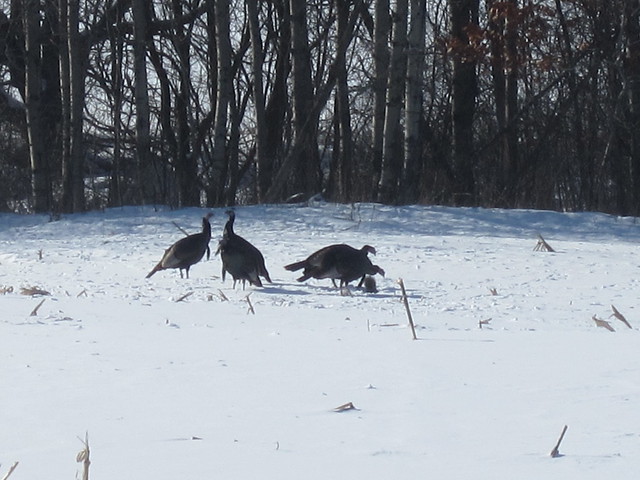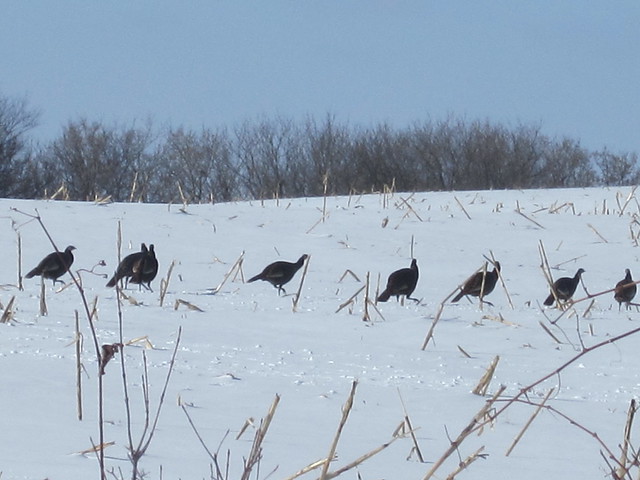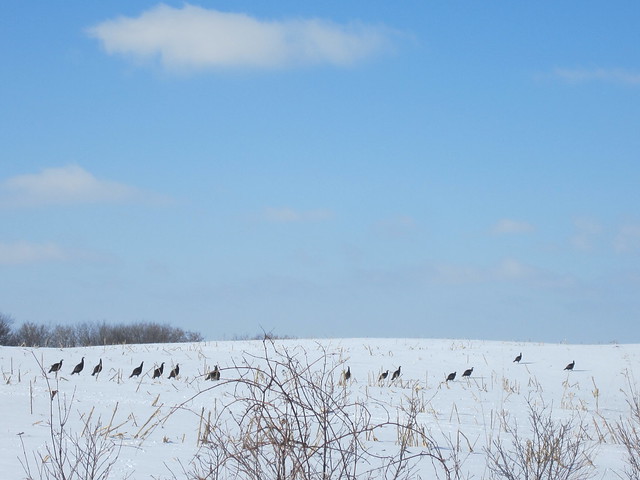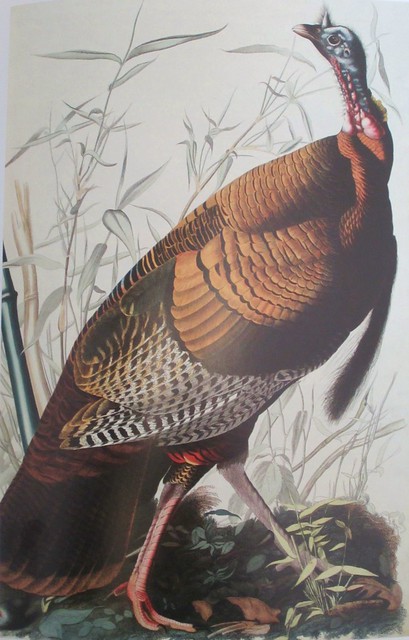Slowly, as the years passed, the turkeys gradually spread and moved north and slowly west. About five or so years ago, we started noticing that the turkeys were getting closer to us.
By Winter 2013, there was a very large of turkeys that were spending lots of time at the farm next door in the wooded area next to cornfield. They would walk between that area, across the road and into another cornfield, and then continue their journey to their nightly roosting spot.
It has been a joy to see the wild turkeys - especially when they are in large flocks. Even if I don't see them, their tracks indicate that they are around and spending time in the neighborhood.
A small group of turkeys looking for food.
You can see the beard on some of the turkeys if you look closely.
Taken on February 5, 2013.
For this nature study, I had scheduled it to be done by November 21st. With preparing for the holidays, and music and theater performances that required lots of practicing at home and church we didn't do this nature study until December.
Nonetheless, it was equally as interesting in December as it would have been a month prior.
First, we read about wild turkeys in The Handbook of Nature Study on pages 138-140. We learned:
=> The bronze breed most closely resembles our native wild turkey.
=> The feathers have a glittering bronze with greenish and purple iridescence, and each feather is tipped with a narrow jet band.
=> There is a tassel of black bristles called the beard which hangs limply downward when the birds are feeding; but when the male stiffens his muscles to strut, this beard is thrust proudly forth.
=> The heads of all are covered with a warty wrinkled skin, bluish white on the crown, grayish blue about the eyes, and the other parts are red.
=> Beneath the throat is a hanging fold called the wattle.
=> Above the beak is a fleshy pointed knob called the caruncle, which on the male is so prolonged that it hangs over and below the beak.
=> When the bird is angry, the carunculated parts swell and grow vivid in color, seeming to be gorged with blood.
=> The eyes are bright, dark hazel with a thin red line of iris.
=> The ear is just behind the eye and very tiny, yet is extremely efficient and can hear the smallest sounds.
=> The legs of the young turkeys are nearly black, fading to a brownish gray when mature.
=> The middle toe of the three front ones is nearly twice the length of the one on either side; the hide toe is the shortest of the four.
=> The spur is a very effective weapon.
=> The wings are large and powerful; and the turkey can fly well for such a large bird.
=> They roost high, choosing trees or the ridgepole of the barn.
The turkeys were all lined up in a row.
There were both males and females in this flock
Taken on February 5, 2013.
I had to laugh at this description of a male turkey because it reminded me of the ones we had here: "The gobbler is the most vainglorious bird known to us; when he struts to show his flock of admiring hens how beautiful he is, he lowers his wings and spreads the stiff primary quills until their tips scrape the ground, lifting meanwhile into a semicircle fan his beautiful tail feathers; he protrudes his chest, and raises the iridescent plumage of his neck like a ruff to make a background against which he throws back his red, white, and blue decorated head."
Turkeys in a corn field.
This flock was walking towards its evening roosting spot.
At dusk and daybreak the turkeys could be seen roosting
in the high branches of trees in a forested area.
Taken on February 5, 2013
The Handbook of Nature Study had even more facts that we found interesting:
=> Turkey hens usually begin to lay in April. She strays off a lone, seeking the most secluded spot she can find to lay the large, oval, brown-speckled eggs.
=> Incubation takes four weeks.
=> Turkey nestlings are rather large, with long, bare legs and scrawny, thin necks. They are very delicate during the first six weeks of their lives.
Drawing by John Audubon.
After we read about turkeys, Sophia and Olivia both did an entry in their nature journals.
Olivia incorporated photographs that were in the newspaper's Outdoor section in November.
Sophia did her own drawing and included facts she found from various sources.
When we were done with the lesson about turkeys, I gave each of the girls a Running List of Mammals that is available on the Handbook of Nature Study website. It looks like a great way to keep track of the mammals that they see during the winter.








No comments:
Post a Comment